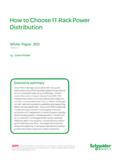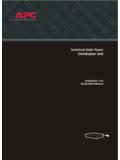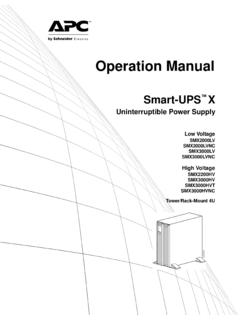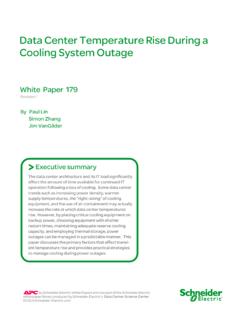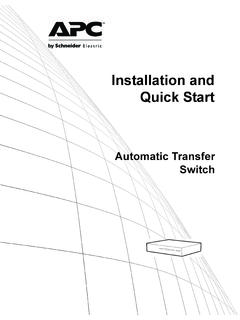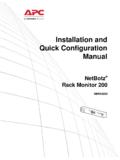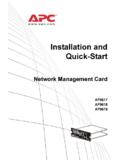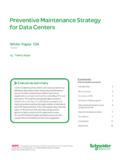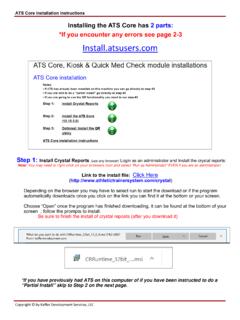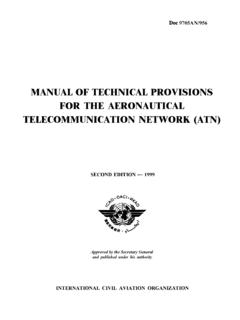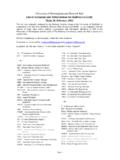Transcription of Essential Standby Generator System Requirements …
1 Essential Standby Generator System Requirements for Next Generation Data Centers Revision 1 by Matt LePard Introduction 2 Inadequacy of current Generator systems for IT managers 2 Generator System challenges in mission critical installations 3 Standby Generator systems for mission critical installations8 Conclusion 9 Resources 10 Click on a section to jump to it Contents White Paper 90 Effective Standby Generator System installations must address the known problems and challenges relating to current and past designs. This paper presents a categorized and prioritized overview of Generator System challenges and the Requirements needed to overcome them.
2 Executive summary> white papers are now part of the Schneider Electric white paper libraryproduced by Schneider Electric s Data Center Science Center Essential Standby Generator System Requirements for Next Generation Data Centers Schneider Electric Data Center Science Center White Paper 90 Rev 1 2 Standby power generation is a key component of a high availability power System for data centers and network rooms. Information technology systems may operate for minutes or even a few hours on battery, but local power generation capability is key to achieving high availability. In locations with poor utility power, local power generation may be needed to achieve even a minimal requirement of availability. Generator systems with diesel or natural gas engines are, in most cases, the solution for Standby power generation.
3 A Generator System includes not only the Standby Generator , but also the automatic transfer switch (ATS), the output distribution, and the communication or management System as shown in Figure 1. The ATS is fed by two sources, the utility and the Generator , with the utility the preferred source. When the preferred source is unaccepta-ble, the ATS automatically switches to the Generator . White Paper 93, Fundamental Prin-ciples of generators for Information Technology, provides a detailed explanation of the operational principles of Generator systems. Standby Generator systems are typically used in conjunction with UPS systems. There are several issues that need to be considered when choosing, installing and operating a genera-tor System that operates seamlessly with a UPS. This paper outlines the key problems and Requirements for effective selection and operation of a Generator System to support today s mission critical data centers.
4 In the past, data center physical infrastructure (DCPI) such as UPS and Generator systems were solely the responsibility of facilities managers. However, two trends have led to a convergence of facilities and IT. 1. Data centers have become more critical to the profitability of businesses ( down-time is very expensive), which has led IT managers to take more responsibility for the UPS and Generator systems. IT managers are bringing these systems closer to the equipment racks in order to decrease the single points of failure between them and the critical loads. 2. Data center power densities are increasing, which has placed a greater importance on cooling critical loads during power outages. When a power outage occurs, the UPS System maintains the critical load; however the cooling System will not resume opera-tion until after utility power returns.
5 Data centers with high density racks cannot sus-tain a long cooling outage and will shut down before cooling has resumed. Introduction Figure 1 Standby Generator System Fundamental Principles of generators for Information Technology Related resource White Paper 93 Automatictransfer switch(ATS)Utility powerStandby powerLoadsManagementsystemNetworkInadequ acy of current Generator systems for IT managers Essential Standby Generator System Requirements for Next Generation Data Centers Schneider Electric Data Center Science Center White Paper 90 Rev 1 3 Since IT managers are ultimately responsible for the critical data processing that takes place in their data centers, they are becoming more involved in the specification and operation of Generator systems.
6 The challenges presented in this paper are largely based on traditional Generator systems tend to offer too many options and design choices. The many available alternatives often lead to delays in installation, unnecessary engineering costs, and less reliable systems. IT managers require a pre-engineered Generator System with pre-selected and tested options / features that allow for reliable operation. A clean and concise documen-tation package that explains and guides all aspects of installing, configuring, operating, troubleshooting, and servicing the System is also an important necessity. In essence, IT managers require turnkey solutions that will allow them to specify Standby Generator systems on their own. A comprehensive analysis of data center and facility managers with mission critical installa-tions was conducted to identify key challenges associated with choosing, installing and operating Standby Generator systems.
7 The results of the analysis were grouped according to common concepts. For each group, a solution requirement was derived and categorized into core challenges. These core challenges were then further grouped into five key theme areas: Manageability Availability / Reliability Maintenance / Serviceability Lifecycle cost Adaptability For each theme area, the challenges, underlying problems, and Generator System require-ments are presented in tabular form in Tables 1 - 5. The highest priority challenges are listed first under each theme. Generator System challenges in mission critical installations Essential Standby Generator System Requirements for Next Generation Data Centers Schneider Electric Data Center Science Center White Paper 90 Rev 1 4 Challenge Underlying problems Generator System Requirements Monitor and display Generator System status It is important that the operator can easily see that the System is working.
8 In many cases there are Generator System parameters which can not be easily monitored and understood by the operator ( fuel level, oil level, battery status, etc.) A Generator System that measures the most important parameters and displays them to the operator in a meaningful way. For example, instead of showing how much fuel is left, it would be more meaningful for the IT manager to know the run time remaining at current load whether or not the Generator is running. Provide predictive failure analysis Users need to know beforehand if some aspect of the Generator System is going to fail so proper preventative measures can be taken. A management System that monitors all Generator subsystems and provides early warning through preventative maintenance reminders. Real time remote and local monitoring System that provides critical information and alarms at every interface: Battery monitoring and weak battery detection An automatic alarm that is sent whenever the controller is not set to automatic, the emergency stop is engaged, or the Generator output breaker is not closed Block temperature and coolant level monitoring and alarms Fuel level and load power measurements, available even when the Generator is in Standby Oil level monitoring so that oil can be added or leaks repaired, rather than waiting for the Generator to start and shutdown due to low pressure Manage System with an intuitive interface It may be difficult for various systems within an organization to interface and may not be user friendly.
9 A management, control and communication System that is simple, functional, and familiar to IT operators. Embedded help within the user interfaces and factory defaults set to ensure proper System functionality. Know when service is required and how to plan for it. Sometimes it may be difficult to find and / or interpret the service log. This may cause unnecessary confusion. A diagnostic System that reminds the user when maintenance is required both in operating hours as well as in calendar time. This information should be available in various ways such as on the local ATS interface, and via SNMP or other web-based protocol. Have visibility to Standby Generator System ATS and power distribution panels are typically hidden in a back room far away from the IT equipment. This makes it difficult to find them and quickly diagnose status and problems.
10 ATS and power distribution that have a look-and-feel that is suitable for data center environments. A System that can be installed in close proximity to the load to improve visibility and control. It is important that the management System be designed in such a way that it fits the need of the daily operation. The needs of server room operators are sometimes different from the needs in other applications. The parameters shown must relate purely to the operation and status of the System and should be presented in such a way that makes it very easy to understand. For example, it is more intuitive for the System to display the remaining runtime instead of remaining fuel. These challenges clearly suggest the need for pre-engineered, pre-tested, and standardized management tools that support not only the Generator but all of the Generator System components including the ATS.
